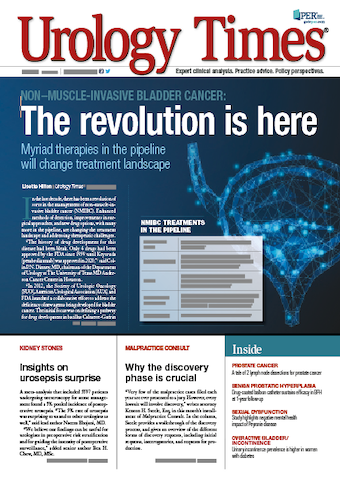Publication
Article
Urology Times Journal
PSMA theranostic 177Lu-PSMA-617 approaches prime time in mCRPC
Author(s):
The PSMA-targeted radiopharmaceutical 177Lu-PSMA-617 (LuPSMA) is rapidly advancing through the pipeline in metastatic castration-resistant prostate cancer (mCRPC), Scott T. Tagawa, MD, explained during the 2021 New York GU 14th Annual Interdisciplinary Prostate Cancer Congress® and Other Genitourinary Malignancies.1
Scott T. Tagawa, MD

In a session covering all radiopharmaceutical developments in mCRPC, Tagawa, professor of Medicine and Urology at Weill Cornell Medicine, and an attending physician at NewYork-Presbyterian/Weill Cornell Medical Center, spent a key segment focusing on LuPSMA, which is poised to become one of the first PSMA theranostics approved by the FDA.
Tagawa started this segment by highlighting the first prospective study of LuPSMA, which was a single-arm phase 2 trial conducted exclusively at the Peter MacCallum Cancer Centre in Melbourne, VIC, Australia.2 The investigators enrolled men aged ≥18 years with mCRPC and disease progression. Patients had received taxane-based chemotherapy and second-generation antiandrogens, such as abiraterone acetate (Zytiga) and enzalutamide (Xtandi).
High PSMA expression was confirmed through a PSMA screening. Patients received a maximum of 4 cycles of IV Lu-PSMA. The primary end point of a ≥50% decline in PSMA from baseline was reached by 57% (n = 17) of 30 evaluable patients. Hofman et al also observed clinically meaningful improvements in pain severity and interference scores.
Regarding safety, the most frequently occurring adverse events among the 30 patients were grade 1 dry mouth (87%), grade 1/2 nausea (50%), and grade 1/2 fatigue (50%). The investigators also reported that 4 patients (13%) had grade 3/4 thrombocytopenia potentially related to Lu-PSMA treatment.
The next key study of Lu-PSMA was the open-label phase 2 TheraP trial, on which Hofman was also a lead investigator.3 This study randomized men with mCRPC to LuPSMA or cabazitaxel (Jevtana).
“This was a post-docetaxel population and a majority also happened to have received a hormone therapy, but that was not required. A PSA of 20 ng/mL was required to enroll, so higher than most of our CRPC studies that had a primary end point of PSA,” said Tagawa.
Overall, the TheraP trial enrolled 200 patients who received imaging with 68Ga-PSMA-11 and 18F-FDG PET/CT confirming high PSMA-expression and no sites of FDG-positive/PSMA-negative disease. Over 90% of patients in each arm had received abiraterone acetate, enzalutamide, or both.
Patients were randomized in a 1:1 ratio to LuPSMA (n = 99) or cabazitaxel (n = 101). Study treatment occurred at 11 clinical locations in Australia. PSA response rate was the primary study end point. A PSA response was defined as a ≥50% reduction.
The results showed that the PSA response rate was 66% with LuPSMA compared with 37% with cabazitaxel, representing a 29% absolute greater PSA response rate (P <.0001). For sensitivity analysis per protocol, the difference observed was 23% (P = .0016).
LuPSMA delayed progression versus cabazitaxel (HR, 0.63; P = .0028), with a comparable benefit observed in radiographic progression-free survival (PFS; HR, 0.64; P = .0070) and PSA-PFS (HR, 0.60; P = .0017).
“This was an open-label study, and patients randomized to cabazitaxel sometimes did not accept therapy. But the sensitivity analysis still showed a [PSA response] benefit with LuPSMA, and also a PFS benefit,” said Tagawa.
The safety analysis included 98 men in the LuPSMA arm and 85 in the cabazitaxel arm. Grade 3/4 AEs occurred in 33% (n = 32) and 53% (n =45) of the 2 arms, respectively.
Summarizing the main safety takeaways from TheraP and other early prospective assessments of LuPSMA, Tagawa said, “Prospectively, all studies [of LuPSMA] have shown that the majority of patients get some xerostomia, meaning greater than 50%. And you can see that dry mouth as well as thrombocytopenia were the toxicities that were higher with LuPSMA as opposed to cabazitaxel. Luckily, the vast majority of these were grade one, and most got better. But grade 3 is really bad…so just kind of keep that in mind.”
During his presentation, Tagawa mentioned that the next milestone for LuPSMA would be the eagerly awaited results of the phase 3 VISION trial. Subsequent to Tagawa’s presentation, it was reported that in the VISION study, adding LuPSMA to best standard of care (BSC) improved overall survival (OS) in patients with progressive PSMA-positive mCRPC.4
The open-label phase 3 VISION trial (NCT03511664) accrued patients with progressive PSMA-positive mCRPC who received at least 1 novel androgen axis drug (eg, enzalutamide [Xtandi] or abiraterone acetate [Zytiga]) and were previously treated with 1 to 2 taxane regimens. Patients were randomized to LuPSMA plus BSC or BSC alone. The coprimary end points of the trial were OS and PFS.
Beyond OS, LuPSMA also extended PFS when added to BSC versus BSC alone. No new safety signals emerged in the trial.
Data from the study will be presented at a future scientific conference, according to Novartis, the developer of LuPSMA. The company also plans to submit the findings to regulatory authorities to receive approval of LuPSMA for patients with mCRPC.
References
1. Tagawa S. Therapeutic Radiopharmaceuticals: Past, Present, and Future. Presented at: 2021 New York GU 14th Annual Interdisciplinary Prostate Cancer Congress® and Other Genitourinary Malignancies, hosted by Physicians’ Education Resource, LLC (PER®); Virtual.
2. Hofman MS, Violet J, Hicks RJ, et al. [(177)Lu]-PSMA-617 radionuclide treatment in patients with metastatic castration-resistant prostate cancer (LuPSMA trial): a single-centre, single-arm, phase 2 study. Lancet Oncol. 2018 ;19(6):825-833. doi: 10.1016/S1470-2045(18)30198-0
3. Hofman MS, Emmett, L Sandhu S, et al. [177Lu]Lu-PSMA-617 versus cabazitaxel in patients with metastatic castration-resistant prostate cancer (TheraP): a randomised, open-label, phase 2 trial. Lancet. 2021;397(10276):797-804. doi: 10.1016/S0140-6736(21)00237-3
4. Novartis announces positive result of phase III study with radioligand therapy 177Lu-PSMA-617 in patients with advanced prostate cancer. Published online March 23, 2021. Accessed March 23, 2021. https://bit.ly/397IZ1i.





























